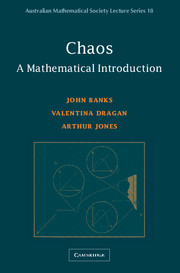Book contents
- Frontmatter
- Contents
- Preface
- 1 Making predictions
- 2 Mappings and orbits
- 3 Periodic orbits
- 4 Asymptotic orbits I: linear and affine mappings
- 5 Asymptotic orbits II: differentiable mappings
- 6 Families of mappings and bifurcations
- 7 Graphical composition, wiggly iterates and zeroes
- 8 Sensitive dependence
- 9 Ingredients of chaos
- 10 Schwarzian derivatives and ‘woggles’
- 11 Changing coordinates
- 12 Conjugacy
- 13 Wiggly iterates, Cantor sets and chaos
- Index
1 - Making predictions
Published online by Cambridge University Press: 05 June 2012
- Frontmatter
- Contents
- Preface
- 1 Making predictions
- 2 Mappings and orbits
- 3 Periodic orbits
- 4 Asymptotic orbits I: linear and affine mappings
- 5 Asymptotic orbits II: differentiable mappings
- 6 Families of mappings and bifurcations
- 7 Graphical composition, wiggly iterates and zeroes
- 8 Sensitive dependence
- 9 Ingredients of chaos
- 10 Schwarzian derivatives and ‘woggles’
- 11 Changing coordinates
- 12 Conjugacy
- 13 Wiggly iterates, Cantor sets and chaos
- Index
Summary
When ancient societies wished to discover what the future held for them they consulted their soothsayers. The methods by which the soothsayers made their predictions now appear to us as quite strange: observing the entrails of animals, noting the position of the planets or viewing the gleam of sacred stones.
Nowadays we prefer predictions to be based on scientific theories. Most branches of science embody assumptions (or laws) which can be expressed as mathematical equations. Predictions are made by solving the mathematical equations and then interpreting their solutions in terms of the original scientific problem. In this chapter we illustrate these ideas by drawing on just one area of science: the theory of population growth. This area is sufficiently familiar that its basic assumptions can be understood easily. At the same time, the equations to which it leads can have solutions with extremely complicated behaviour patterns, leading to chaos.
The chaotic behaviour of the solutions has far reaching implications for the future of scientific endeavour: for many scientific experiments, accurate predictions of the long term outcomes may not be possible.
MATHEMATICAL MODELS
In most scientific theories the assumptions (or laws), and the equations to which they lead, do not represent the original problem with complete accuracy. Hence the equations (and the assumptions) are only a model whose purpose is to capture the essential features of the original problem while ignoring incidental details.
- Type
- Chapter
- Information
- Chaos: A Mathematical Introduction , pp. 1 - 26Publisher: Cambridge University PressPrint publication year: 2003



